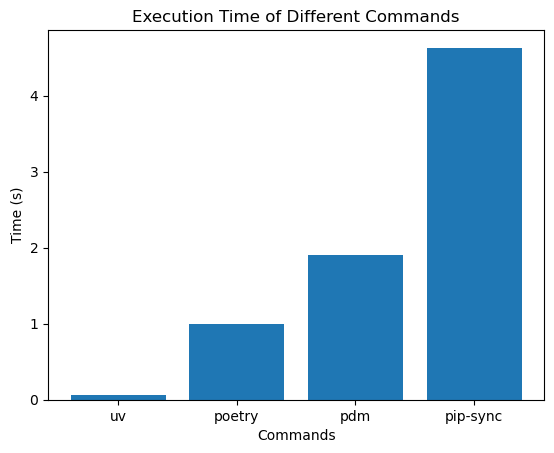Guide To UV Python: Manage Your Package Dependencies
As a developer, you know that speed and efficiency are crucial when working with Python. In this ever-evolving landscape, UV, a revolutionary package manager written in Rust, is poised to revolutionize how developers manage their dependencies and projects. With its unparalleled performance, reliability, and comprehensive project management capabilities, UV is poised to become the go-to tool for modern Python developers.

Why UV Stands Out from the Rest
UV is more than just a package manager – it’s a game-changer that combines speed, reliability, and comprehensive project management into one powerful tool. It replaces traditional tools like pip, pip-tools, pipx, poetry, pyenv, twine, and virtualenv, offering a unified and streamlined experience. Here are some key reasons why UV is making waves in the Python community:
- Lightning-Fast Performance: With speeds of 10-100x faster than pip, UV is the ultimate solution for developers who need to manage their dependencies quickly and efficiently.
- Universal Lockfile: UV provides a universal lockfile that ensures consistency across different environments, making it easier to maintain reproducibility in your projects.
- Comprehensive Project Management: With its Cargo-style workspaces and pip-compatible interface, UV is ideal for managing large-scale projects and ensuring a seamless transition from existing tools.
The Benefits of Using UV
By adopting UV as your package manager, you can experience the following benefits:
- Improved Development Speed: With UV’s blazing-fast performance, you can quickly manage your dependencies and get back to writing code.
- Enhanced Project Management: UV’s comprehensive project management capabilities make it easy to manage large-scale projects and ensure consistency across different environments.
- Increased Efficiency: By leveraging UV’s global cache for dependency deduplication and efficient disk usage, you can free up more space on your hard drive.
Getting Started with UV
Installing UV is straightforward, and you can use the official standalone installer or install it via pip, pipx, or curl. Here are some quick installation guides:
# On macOS and Linux: curl -LsSf https://astral.sh/uv/install.sh | sh # On Windows: powershell -ExecutionPolicy ByPass -c "irm https://astral.sh/uv/install.ps1 | iex" # Or via pip: pip install uv #Or via pipx: pipx install uv
Once installed, you can initialize a new project with UV and start adding dependencies:
uv init my_new_project cd my_new_project
Once you process with above command, it creates, below file structure within my_new_project folder.
.
├── .gitignore
├── .python-version
├── README.md
├── main.py
└── pyproject.toml
later, you can modify pyproject.toml file add add the relevant dependecies such as pandas, openai. Below is the example file which you can use for pyproject.toml
[project]
name = "my-new-project"
version = "0.1.0"
description = "describe your project description"
requires-python = ">=3.10"
dependencies = [
"uvicorn>=0.30.0",
"openai>=1.0.0",
]
# This creates uv.lock with pinned versions for reproducibility. uv synv
Once you do uv sync command on the terminal, it will create uv.lock file with list of dependencies. The installation of all the dependant libraries gets listed in the uv.lock file.
Some basic UV commands:
# to add new library as dependencies to the project uv add pandas # to remove existing library as dependencies to the project uv remove pandas # to run a python script uv run main.py # to display project tree uv tree # to create a virtual environment uv venv .venv # Manage Python packages with a pip-compatible interface. uv pip install numpy # Build Python packages into source distributions and wheels. uv build
UV vs PIP vs Poetry vs Conda Comparison
To help you understand how UV compares to other popular Python package managers like pip, here’s a detailed comparison:
| Feature | UV | pip | Poetry | Conda |
|---|---|---|---|---|
| Performance | 10-100x faster | Standard | Moderate | Moderate |
| Configuration File | | requirements.txt | pyproject.toml | environment.yml |
| Lock File Support | Yes (generated) | No | Yes (poetry.lock) | Yes (conda.lock) |
| Virtual Environment | Built-in | Manual | Built-in | Built-in |
| Package Publishing | Built-in | Requires setup | Built-in | Built-in |
| Python Version Handling | Built-in | None | External tools | Built-in |
| Cross-Platform Support | macOS, Linux, Windows | macOS, Linux, Windows | macOS, Linux, Windows | macOS, Linux, Windows |
In conclusion, UV is more than just a fast package manager – it’s a comprehensive tool that enhances the Python development experience. Whether you’re managing a small script or a large-scale project, UV’s speed, reliability, and robust feature set make it an indispensable tool for modern Python developers.
By adopting UV as your package manager, you can unlock the full potential of Python development and experience unparalleled efficiency and performance in your workflow. So why wait? Try UV today and discover a new way to develop! Do let me know in comments section your experience with UV.





